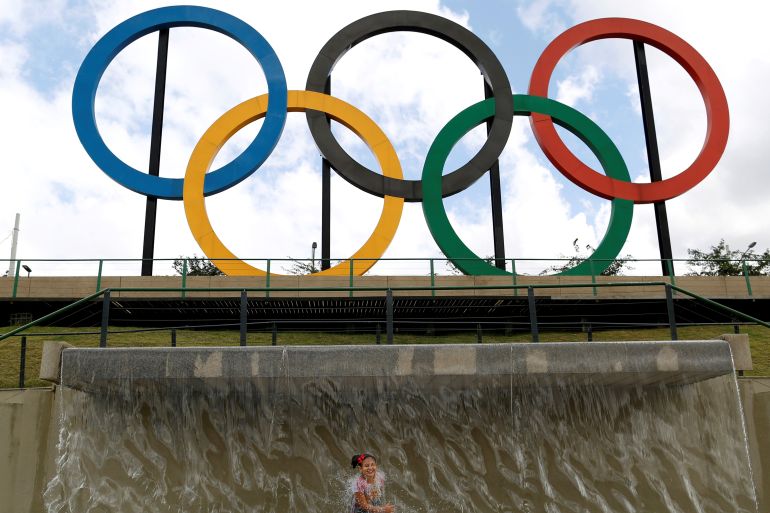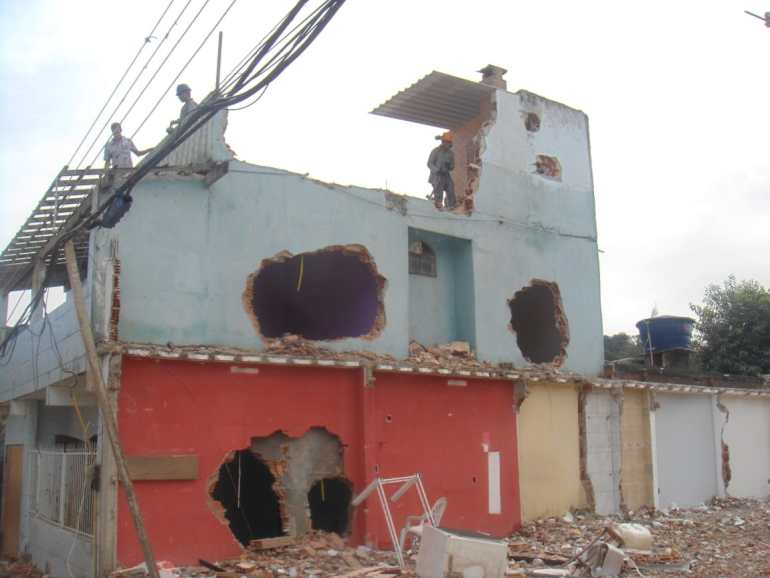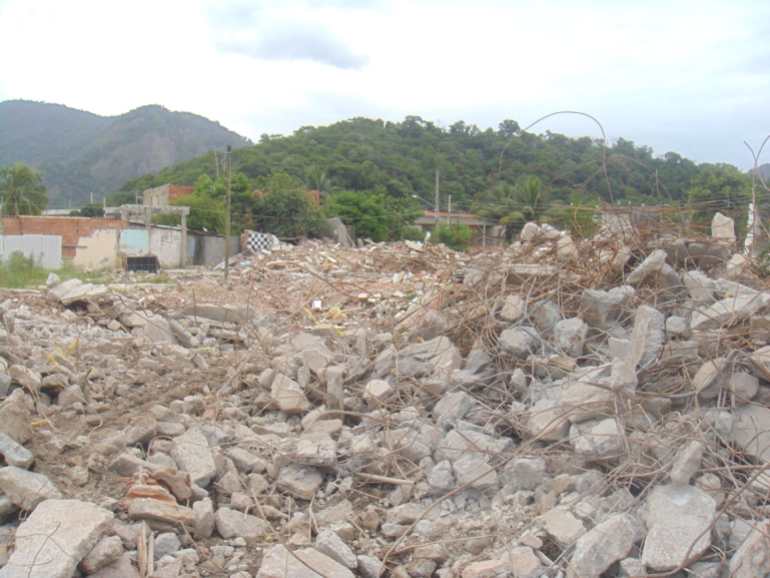Five years on: Revisiting Rio 2016 Olympics’ unkept promises
All eyes are on Paris for the 2024 Olympics but Rio residents are still waiting for promises to be delivered.

Last month, Tokyo handed over the Olympic flame to Paris after the culmination of the rearranged 2020 Olympics.
Watching proceedings were people in Rio – which hosted the Games in 2016 – who are still waiting for the fulfilment of several promises from more than five years ago.
Keep reading
list of 4 itemsIndonesia’s Christie takes Asia badminton crown ahead of Paris Olympics
Akebono, sumo’s first foreign-born grand champion, dies aged 54
Track and field becomes first sport to pay prize money at Olympics
Rio 2016 was expected to not only increase tourism numbers and the improvement of the country’s image outside Brazil, but also leave a legacy on public safety, create new job opportunities, an integrated public transport system and urban projects, from which the population could benefit long term.
The public policy plan for the legacy of the Rio 2016 Games stated that “legacy is a set of infrastructure works (including sports) and public policies in the areas of mobility, environment, urbanization, education and culture that are under way and have been accelerated or made possible by the fact the city of Rio de Janeiro hosted the Games in 2016”.
There were 27 projects in the legacy plan – set in 2014 by municipal, state and federal governments – with little connection to the Games but which would be facilitated by it, such as the expansion of transport lines.
The idea was to leave functional installations behind and “no white elephants”, as Eduardo Paes, Rio mayor at the time, promised during the preparations for the Games.
The main projects in Rio comprised the Olympic Boulevard (the area between the port and downtown), the Metro Line 4, the Olympic Park and the Bus Rapid Transit (BRT).
But none of those projects reached completion.

The works on the Gavea section of the metro – that would link the south zone to the west one – have not made any progress since 2015.
The Olympic Park has hosted a few sporting events and even Rock in Rio, the initial project plan to build four schools from the dismantling of the Arena of the Future – where the handball competitions took place – has not been delivered and the venue is still standing.
While the Brazilian Olympic Committee used some of the facilities as training bases for national team athletes, not one became a permanent training centre.
The Cidade Olímpica Museum, inaugurated in 2016 at Engenhao Stadium, exhibits the history of the Olympics. Through the use of technology, visitors can fly over Rio using virtual reality to visit sights.
But the museum was shut down in 2019. The Municipal Department of Science and Technology, responsible for the venue, has not given a reason but declared it was already out of service during the previous administration but a reopening is expected later this year.
A City Hall administrator told Al Jazeera that “the previous mayor of Rio, in the last four years, has left everything abandoned”.
The Rio 2016 Organising Committee and several of its representatives did not respond to Al Jazeera’s repeated requests for an interview.
The Olympic Legacy Governance Authority (AGLO), responsible for supervising and promoting the activities in the sports structures that remained after the Rio 2016 Olympic and Paralympic Games, was dissolved by President Jair Bolsonaro in 2019.
This means that there exists no specific organisation in charge of overseeing the legacy.
The Olympic Public Authority (APO) says officially the total amount spent on Rio 2016 was a little over 39 billion Brazilian real (around $7.4bn today).
In addition to that amount, more money was put aside, including the indemnification offered to residents of Vila Autodromo who were removed from their homes to make room for the construction of the Olympic Park.

The municipal government, in 2013, started to evict about 650 families who lived at the Vila because, according to the administration, they were blocking the access road to the park.
The residents of the improvised community were presented with two options: financial compensation or relocation to a condominium not too far from where they were.
Sandra Maria Souza was part of one of 20 families who resisted fiercely and did not accept either of the offers.
She arrived at the favela in 1991 and raised her four children there. The acupuncturist recalls that when she found out about Rio de Janeiro being the Olympics host, she was hopeful the event would provide an opportunity to improve the quality of public spaces, but it had never crossed her mind she would be so negatively affected.
She describes the government’s attitude as being harsh – “Physical violence, threats and psychological pressure”.
When the removal process began, Souza described the living conditions in the community as being “subhuman” because, she said, the Rio government suspended basic services like mail delivery, rubbish collection and street lighting.

This was in addition to other problems: rubble was left behind from the demolished houses, there was a rat infestation due to rubbish accumulation, and stray cats and dogs were left behind by the families who had opted for relocation.
She had to move houses so all the remaining families would be based in the same street where new residences were built. However, she added that that the administration had also promised to rebuild the children’s playground, the cultural centre and other common facilities that were destroyed while also providing regularisation of the current houses.
The agreement was not fulfilled.
In May 2016, Souza, along with her neighbours, founded the Evictions Museum at the Vila, in order to safeguard the memory of what once was the area and to advocate against other forced evictions around the world.
Seven sculptures made from rubble are exhibited there with each representing a significant place that had been removed.
To Souza, the patrimony left by Rio 2016 is the damage.
“The destruction of lives, that’s the legacy to me,” she said.
‘No concrete goals’
Renata Latuf de Oliveira Sanchez wrote her PhD thesis entitled Drawing the Urban: The Legacy of the Rio 2016 Olympics in Barra da Tijuca.
She also sees the Games in Brazil leaving more problems than solutions. The issue, she told Al Jazeera, was that it lacked planning from the decision makers.
“Everything was done without a joint long-term legacy plan,” said Sanchez. “The plan needs to set concrete goals for five, 10, 20 or even 50 years. Otherwise, other projects and supposed priorities end up taking over and the existing built set is left aside by those who assume office next.”
Paes, re-elected as Rio mayor last year, has meanwhile defended the work carried out for the Olympics.
“Regarding mobility, we achieved a real transformation by constructing three BRT lines and expanding the subway,” the city hall states.
“Rio was left an intangible legacy similar to that of Barcelona 1992.”
Souza, though, does not agree. A public transport user, she claims the BRTs were an excuse to remove various bus lines, which were very useful to the population.
“To go to certain places, we used to take only one bus, now there are times we are forced to take three, increasing the cost of the ticket and the commute time.”
The Federal Public Ministry and the Court of Accounts of the Union have pointed out suspicions of overbilling in the construction works during Rio 2016, as well as reporting a lack of solid plans to manage the facilities.
The president of the Brazilian Olympic Committee (COB) for 22 years, Carlos Arthur Nuzman, was arrested in 2017 for corruption and criminal organisation after allegedly purchasing votes of directors of the International Olympic Committee for the choice of Rio as the venue for the Games.
Environmental preservation was also an aspect that lacked implementation.
Among the commitments that were not fulfilled were the clean-up of the lagoon and Guanabara Bay, where the sailing competitions were held.
The sewage and rubbish flowing into the bay should have been reduced by 80 percent by 2016. The commitment was made by the Sergio Cabral government during the campaign to choose Rio as host city.
It is estimated by the State Water and Sewage Company (CEDAE) that less than 40 percent of wastewater is currently treated.
Not all was unfavourable, though. Flood control for those who live near the Maracana was finally started.
In addition, English was taught to approximately 10,000 taxi drivers and 70,000 volunteers through free online language classes.
But just before the start of the Tokyo Games earlier this year, Mayor Paes decided to renew his unfulfilled promises.
On July 22, he said the initial legacy’s projects would resume after some adaptations.
The four sport-oriented schools to be constructed at the Arena of the Future should be inaugurated at the beginning of 2023 and other venues for playing sports should be at the community’s disposal, plus an offer of free activities and courses.
But the plan comes with a price. Just the dismantling of the Arena and the Aquatic Center will cost an extra 78 million real ($15m).
Sanchez says there was a lack of promotion, investment and partnership in the initiatives associated with Rio 2016. But despite that, she believes the situation can change.
“There is still time to change the mindset, but continued organisation, investment and planning is needed despite the change in government at each election.”